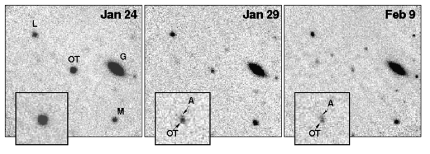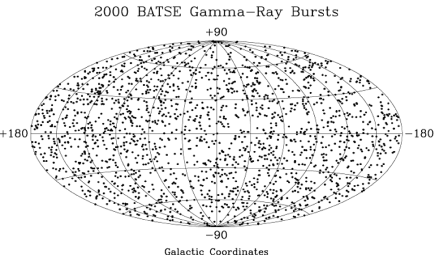Gamma-Ray Burst - Introduction
II. GRBs - What we know and what we don't know
1. We know what they look like in time in gamma-ray wavelengths

Perhaps the most striking feature of the time profiles of gamma-ray bursts is the diversity of their time structures. Some burst light curves are spiky with large fluctuations on all time scales, while others show rather simple structures with few peaks. However, some bursts are seen with both characteristics present within the same event! However, no persistent, strictly periodic behavior has been seen from gamma-ray bursts. A common quote amongst gamma-ray astronomers is "If you've seen one gamma-ray burst, you've seen one gamma-ray burst!"
The durations of gamma-ray bursts range from about 30 milliseconds to over 1000 seconds, although the duration of a gamma-ray burst is difficult to quantify since it is dependent upon the sensitivity and the time resolution of the experiment which observes the event. The "tip of the iceberg" effect tends to cause weaker bursts to be observed as shorter, since only the higher parts of the peak emission are observable.
2. We are beginning to know what they look like in other wavelengths
Gamma-ray bursts were named when they were discovered in the early 1970s; at that time, they seemed to only emit radiation in the gamma portion of the spectrum. Scientists thought it was odd that the bursts appeared to only give off one form of energy. Most other energy sources give off several forms of energy simultaneously. A flame, for instance, gives off infrared (heat) and visible light. As it turns out, gamma-ray bursts are more than just explosions emitting gamma-rays. Now we know that it was our ability to see, rather than the source, which was limited. Individual telescopes were only designed to see one part of the electromagnetic spectrum. When a gamma-ray telescope detects a burst, there was usually not enough time to direct other telescopes to look at the explosion. All of this is now changing. For GRB 990123, the ground-based Robotic and Optical Transient Search Experiment (ROTSE) coordinated with the space-based Compton Gamma-ray Observatory within 20 seconds of the start of the explosion - just quick enough to catch a burst in action in multiple wavelengths.

Three images from the Keck I telescope of the field of GRB 990123 (24 January 1999 UT, 29 January 1999, and 9 February 1999 UT). The image is rotated to the standard orientation, so that the east is to the left and north is up. By looking at the inset image blowups, it is clear that in the 24 Jan image, the optical transient (OT) believed to be associated with the GRB dominates the host galaxy flux, but by 29 Jan the galaxy is resolved from the OT.
Three images from the Keck I telescope of the field of GRB 990123 (24 January 1999 UT, 29 January 1999, and 9 February 1999 UT). The image is rotated to the standard orientation, so that the east is to the left and north is up. By looking at the inset image blowups, it is clear that in the 24 Jan image, the optical transient (OT) believed to be associated with the GRB dominates the host galaxy flux, but by 29 Jan the galaxy is resolved from the OT.Although the explosion only lasts for a few seconds, the afterglow of a GRB can linger for weeks or even months. The afterglow follows a path down the electromagnetic spectrum, first mostly emitting gamma-rays, then peaking at X-rays, and so on, all the way down to radio waves. Eventually, the afterglow fades completely from our view. Because the afterglow is much longer-lived than the initial explosion, various types of telescopes have been used to study the afterglow. Most of our recent insight about gamma-ray bursts comes from studies of the afterglow, although interpretations of the data are still widely debated.
Every aspect of a burst, from the kind of radiation emitted to the intensity of the explosion, tells its own tale. By figuring out how all these different "points-of-view" fit into the main event, scientists hope to determine what really happens. With GRB 990123, scientists saw for the first time visible light emitted during a gamma-ray burst explosion. Although the burst was 9 billion light years away, the light was so bright observers on Earth could've seen it with a pair of binoculars. Scientists see the emission of this intense visible light as a clue that helps determine the structure of the explosion. Because material is flowing out from the explosion at different velocities, collisions occur. Such collisions in a gamma-ray burst create shock waves that generate various energy wavelengths.
In fact, scientists believe that three kinds of shock waves are associated with gamma-ray bursts: external, internal, and reverse. As the source of a gamma-ray burst explodes, material blows outward, creating an external shock wave traveling away from the source of the explosion. The impact of this fast-moving material pushing against the interstellar medium creates reverse shock waves. Meanwhile, matter still racing outward from the explosion at different speeds generates internal shock waves. These internal shock waves push the reverse shock waves outward. The reverse shock waves still appear to be traveling inward, however, because they are slower and colder than the internal shock waves.

3. We know that they come from every direction in the sky... and from very far away!
The random occurrence of GRBs has been one of the biggest problems with studying them -- we never know where the next burst will come from! In the beginning, scientists thought that the sources of GRBs would all be in our Milky Way Galaxy. This would then cause the distribution of GRB locations to be concentrated along the galactic plane (a line running between (+180 and —180 in the image above). Today, primarily through the data from the BATSE experiment, we know that bursts come from all over the sky with equal probability. And the whole sky is a very big place to try to watch all at once!
Although a long debate had been held concerning whether gamma-ray bursts came from our own Solar System, the Milky Way Galaxy, or much further away, the years 1997 through 1999 provided observations with uncontroversial evidence that GRBs come from the distant reaches of the cosmos. By watching the fading of the optical counterparts of that bursts, astronomers were able to conclude that the explosions were embedded in faint galaxies. For example, a day or so after GRB990123, astronomers used the 10-meter Keck II telescope on Mauna Kea to analyze ultraviolet and visible light from the fading afterglow. Their data showed that the explosion took place about 9 billion light years from Earth!
3. We Don't Know if the Radiation is Beamed
The amount of energy released from a gamma-ray burst boggles the imagination. Exploding with the power of ten million billion suns, only collisions between objects like super-dense neutron stars and black holes have enough energy potential to create such a cataclysmic event. But no one is sure what causes a gamma-ray burst; the mechanism remains a mystery.
As powerful as all gamma-ray bursts are, GRB 990123 was at the top 1 percent of its class. GRB 990123 was so powerful that scientists began to wonder if the light in the burst was beamed rather than dispersed evenly, or isotropically. A beamed explosion is directed like a flashlight, while an isotropic explosion is dispersed outward like the emission from a light bulb. Beaming is actually quite common in the emissions from astronomical objects. Data from the Hubble Space Telescope showed a rapid decline in the optical brightness associated with GRB 9990123. These data provide evidence for the beaming theory, because beamed light appears to dim much more rapidly than isotropic light. A beamed explosion would have all of its power concentrated to a specific area. But an isotropic burst explodes outwards to all points in space, so we would only see the part of the energy directed toward us. Isotropic explosions, therefore, are more powerful than they look. The calculation of a gamma-ray burst's total energy depends on the dynamics of the explosion - an isotropic explosion would be calculated to have much more power than a beamed burst.
If gamma-ray bursts are beamed, the energies we're seeing are less than we first thought, but that also means there are more of them out there that we don't see. If the explosions are beamed in just one direction,only those observers located along the path of the beam would see them. That means that there could be gamma-ray bursts exploding all the time, but because the beams are focused in other directions we don't see them. All is not lost, however! Regardless of whether or not we see the beams of gamma-rays, we would still be able to see their afterglows, because afterglows are always isotropic. If we find afterglows without seeing the initial bursts, that would prove gamma-ray burst explosions are beamed.
4. We Don't Know What Causes GRBs
For one brief moment, long ago in a far-away galaxy, a titanic explosion poured a torrent of gamma-rays into space. Some 12 billion years later -- Dec. 14, 1997 -- this flash of radiation reached Earth. Headlines in newspapers and magazines, dubbed this gamma-ray burst "the most powerful explosion since the Big Bang." While that may be hyperbole (brighter bursts have been observed since) researchers have calculated that this cosmic flash packed 100 times more energy than a supernova explosion and calls into question the popular theory in which GRBs are generated when two neutron stars collide and merge, forming a black hole. Dale A. Frail of the National Radio Astronomy Observatory in Socorro, N.M., noted that to generate the energy associated with the Dec. 14 burst, a large fraction of the rest masses of both neutron stars had to have been converted into gamma-rays. Scientists find this unlikely.
Other damning evidence against this model was discovered in a later GRB — astronomers glimpsed an afterglow at radio wavelengths before finding it in visible light. Such a sequence of events suggests that the burst originated from a place containing a great deal of dust, which blocks visible light but is transparent to radio waves. Stellar nurseries (areas of new star formation) are rich in dust, and previous studies have hinted that several other bursts originated in star-forming locales. Neutron stars probably do not merge within star-forming regions. During the 100 million years or so that it takes for neutron stars to form and merge, they would migrate far from their birthplaces.
Dr. Bohdan Paczynski of Princeton University and many other astronomers now favor another model called a hypernova explosion. Still considered a hypothetical notion, a hypernova may emit 100 times more energy than a supernova. What causes a hypernova remains unknown, although astronomers have proposed that they happen when a very large and rapidly rotating star collapses directly into a black hole.
It is likely that both the neutron star merger theory and the hypernova theory are correct. Future observations will be able to tell, as well as determining if the Universe generates GRBs via other circumstances as well.




